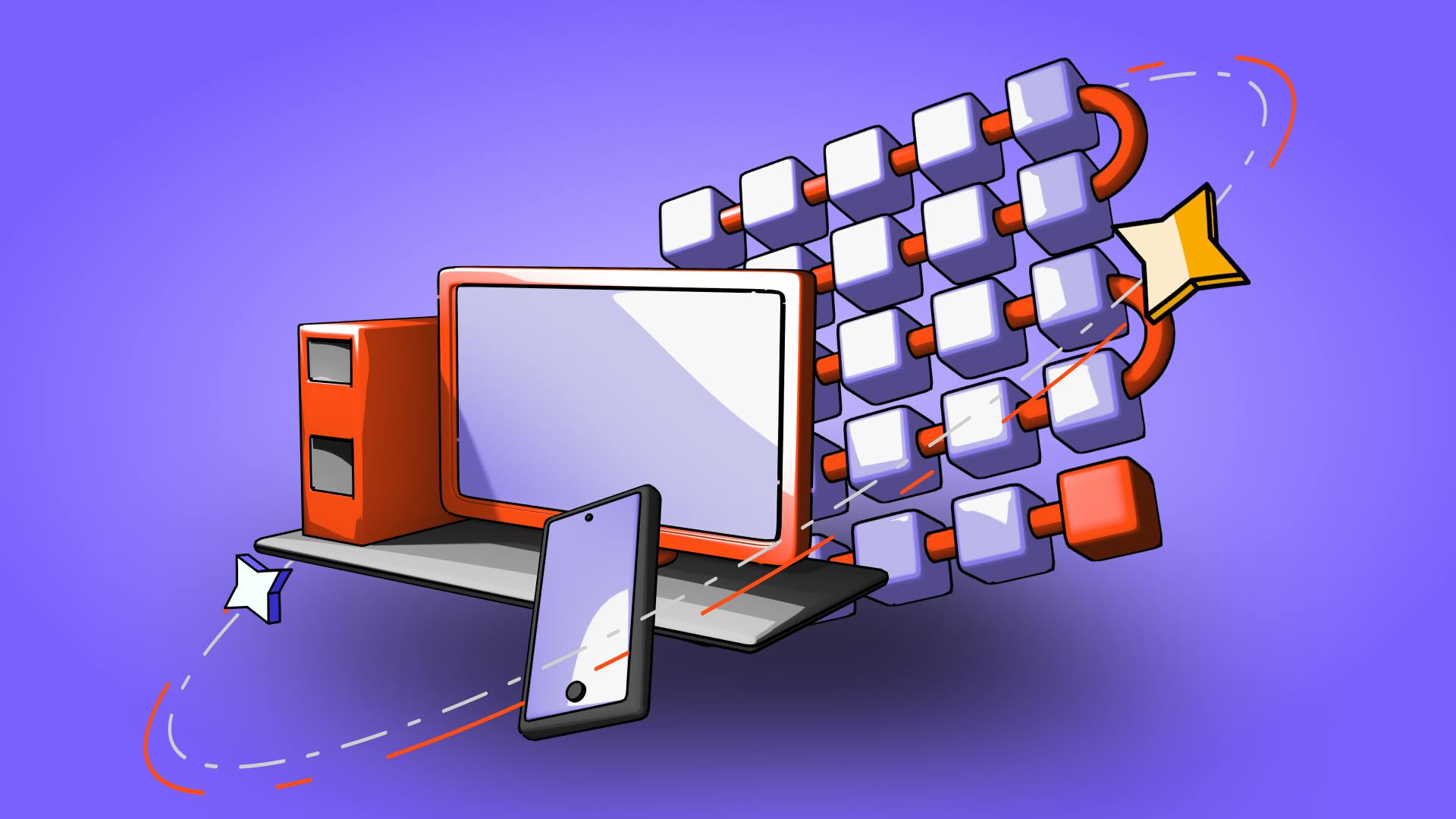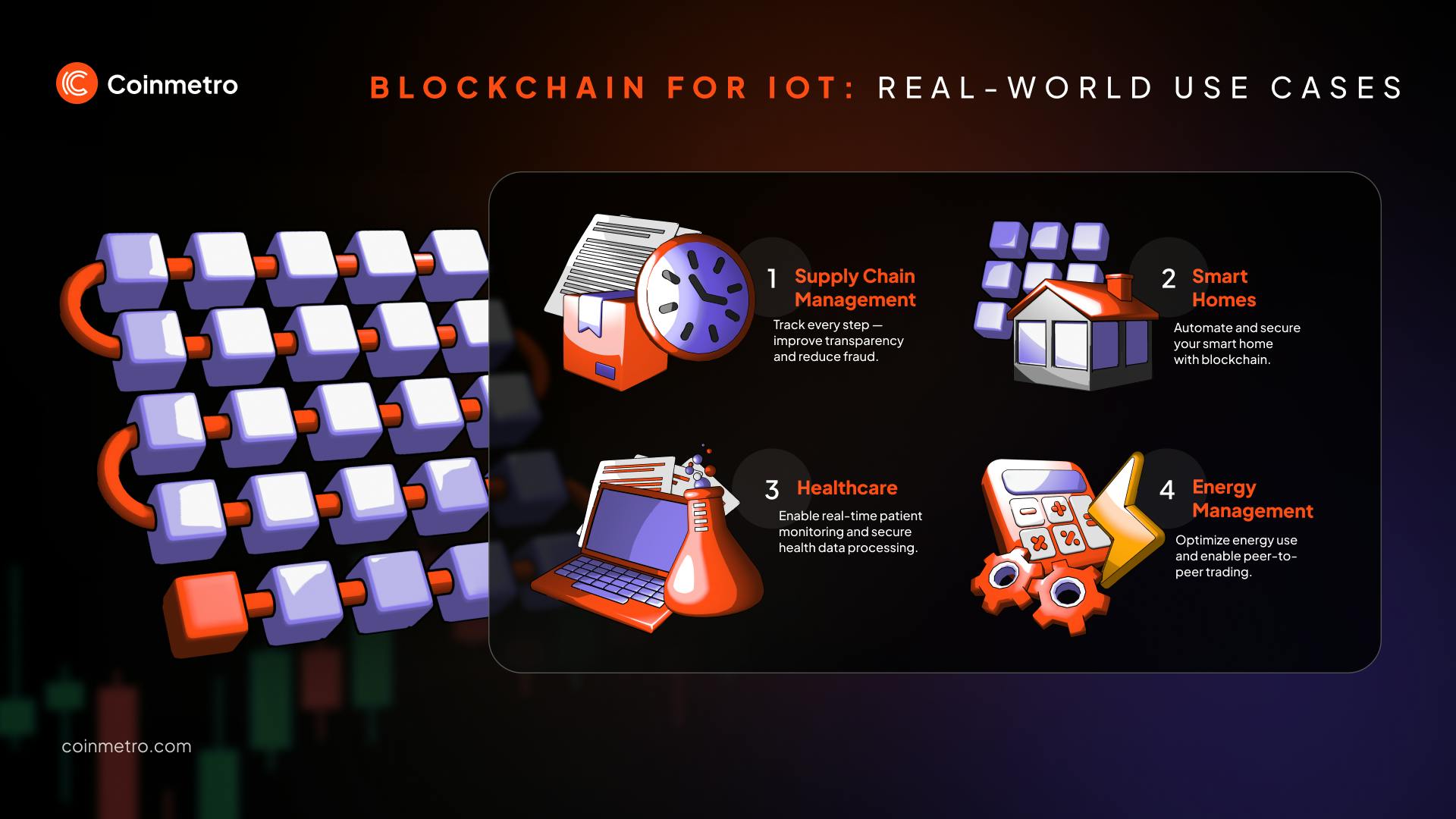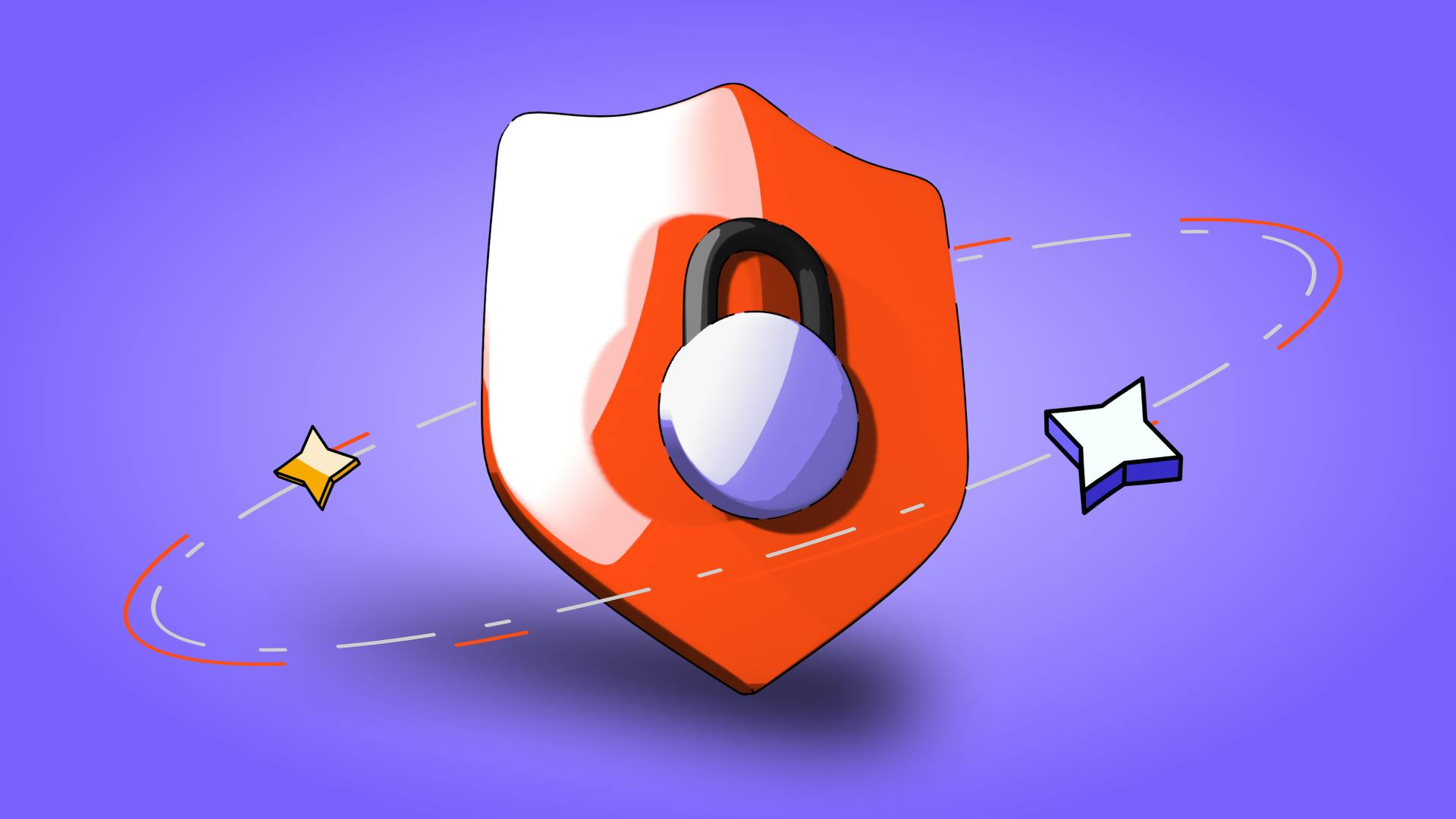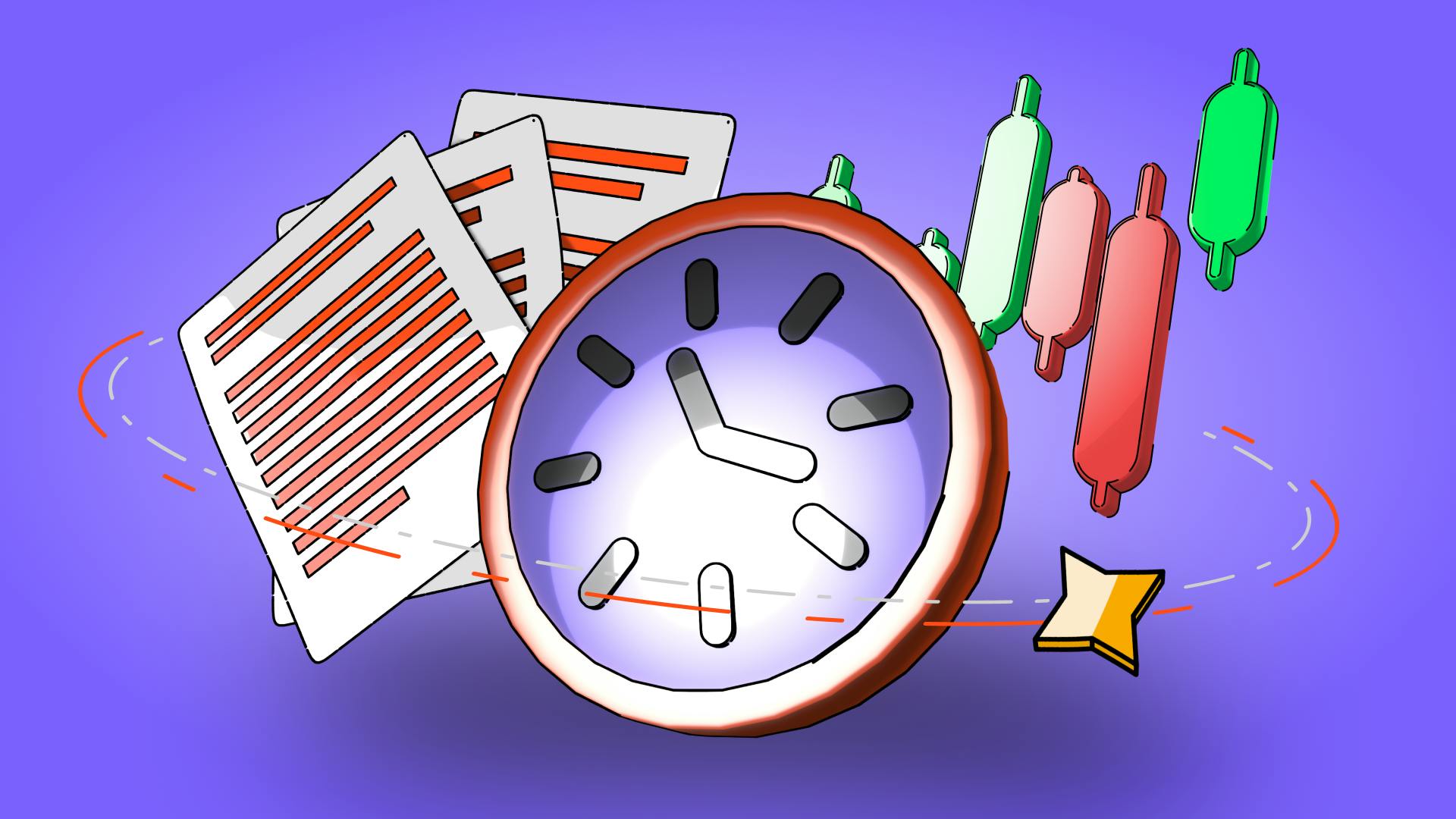Blockchain for IoT (Internet of Things): Enhancing Device Connectivity
December 5, 2025

by Coinmetro Editorial Team
December 5, 2025
The Internet of Things (IoT) hit 17.08 billion devices in 2024. Experts predict this will grow to 29 billion by 2030. IoT now connects consumer electronics and industrial systems widely. This rise brings potential security and connectivity issues for IoT networks. Many devices have weak security, leaving them open to cyberattacks. Handling so many devices requires strong systems for data sharing.
Blockchain technology improves IoT networks with better security and connectivity. Its system spreads data across a secure, clear ledger for all to check. Each record stays safe and cannot be changed easily. This setup lowers the risks of system failures, making IoT stronger. Blockchain uses smart contracts to run devices on their own. These contracts reduce costs and remove the need for middlemen.
This blog will explore the following points:
- What is Blockchain?
- What is the Internet of Things (IoT)?
- Key Benefits of Blockchain in IoT
- Use Cases of Blockchain in IoT
- Future Trends
By understanding the intersection of blockchain and IoT, we can appreciate how these technologies offer a secure, efficient, and scalable solution for the future of interconnected devices.
Learn More: Blockchain Scalability - Solutions, Challenges and Future
Blockchain is a decentralized digital ledger that records transactions across many computers, ensuring secure and transparent transactions. Each transaction is grouped into a block, forming a chain. Originally developed for Bitcoin, blockchain has broad applications beyond cryptocurrencies.
Decentralization: Blockchain operates on a peer-to-peer network, reducing risks associated with centralized control. Each participant (or node) has access to the entire blockchain.
Immutability: Once data is recorded in a blockchain, it cannot be altered. This is achieved through cryptographic hashing, which secures the data.
Transparency: Transactions on a blockchain are visible to all participants, ensuring accountability. Public blockchains like Bitcoin allow anyone to view transactions, while private blockchains restrict access to authorized users.
Security: Blockchain uses cryptographic techniques to secure data. Each participant has a public key and a private key, with transactions signed by the private key to ensure authenticity.
Cryptocurrencies: Blockchain is best known for supporting cryptocurrencies like Bitcoin and Ethereum, securing transactions and eliminating the need for intermediaries.
Supply Chain Management: Blockchain improves transparency in supply chains by recording the journey of products, helping to verify authenticity and reduce fraud. Companies like IBM and Walmart utilize blockchain for this purpose.
Healthcare: Blockchain securely stores and shares patient data, ensuring privacy and seamless access among healthcare providers. Projects like MedRec explore these solutions.
Voting Systems: Blockchain can create secure voting systems, enhancing election integrity. Countries like Estonia are experimenting with blockchain-based voting.
Smart Contracts: These self-executing contracts automatically enforce and execute agreements when conditions are met. Ethereum is a leading platform for smart contracts.
Real Estate: Blockchain streamlines property transfers, reduces fraud, and provides a clear ownership history. Platforms like Propy use blockchain for real estate transactions.
Intellectual Property: Blockchain records the creation and transfer of ownership for intellectual property, ensuring rightful ownership and effective rights management. Projects like Ascribe secure digital art.
Blockchain continues to evolve, finding applications across various industries. Its decentralization, immutability, transparency, and security enhance trust and efficiency in digital interactions.

The Internet of Things (IoT) refers to the network of physical objects—“things”—embedded with sensors, software, and other technologies to connect and exchange data with other devices and systems over the internet. These objects can range from ordinary household items to sophisticated industrial tools. IoT enables these devices to communicate with each other, collect data, and make autonomous decisions based on that data. This interconnected system aims to improve efficiency, productivity, and convenience in various aspects of life and industry.
The growth of IoT has been remarkable over the past decade. As of 2024, there are approximately 17.08 billion IoT devices worldwide, expected to rise to nearly 29 billion by 2030. This rapid expansion is driven by advancements in wireless technologies, increased adoption of smart devices, and the growing demand for automation across different sectors.
IoT significantly impacts various industries:
Consumer Electronics: Smart home devices like thermostats, lights, and security systems allow homeowners to control their environments remotely.
Healthcare: Wearable devices monitor patient health in real-time, providing critical data to healthcare providers and improving patient care.
Manufacturing: IoT enables predictive maintenance of machinery, reducing downtime and increasing efficiency.
Transportation: Connected vehicles communicate with each other and with traffic systems to improve safety and optimize traffic flow.
Agriculture: Smart sensors monitor soil conditions, weather, and crop health, helping farmers make informed decisions and increase yields.
Despite its benefits, IoT faces several challenges:
Security Vulnerabilities: Many IoT devices lack robust security measures, making them susceptible to hacking and cyberattacks. These vulnerabilities can lead to data breaches and unauthorized access to sensitive information and systems.
Data Privacy Issues: IoT devices collect vast amounts of data, often including personal information. Ensuring this data is stored and processed securely is a significant challenge, particularly with varying privacy regulations across different regions.
Connectivity Problems: With billions of devices connected to the Internet, maintaining reliable and fast connections is crucial. Network congestion, latency, and bandwidth limitations can hinder the performance of IoT systems.
Interoperability: Different IoT devices often use various communication protocols and standards, making it challenging for them to work together seamlessly. Achieving interoperability is essential for creating cohesive and efficient IoT networks.
Discover a Beginner’s Guide to Blockchain Consensus Mechanisms
Blockchain boosts security in IoT networks significantly. Traditional systems often face risks from centralized control and weak encryption. Blockchain fixes this by spreading data and using strong encryption methods.
Each transaction is locked and tied to the one before it. This makes it hard for hackers to change data without notice. Blockchain’s verification process ensures only safe transactions reach the ledger.
Blockchain keeps IoT device data accurate and reliable. Each entry is marked with a timestamp and checked by many nodes. This stops tampering and keeps data steady over time.
The system avoids single-point failures, making data more dependable. Blockchain’s fixed records mean data stays unchanged once added. This protects the integrity of all IoT data collected.
Blockchain lowers costs in IoT systems by cutting out middlemen. Traditional setups need third parties to check transactions, which costs money. Blockchain automates this with a secure system and smart contracts. Smart contracts run tasks like payments or data transfers on their own. This speeds up work and cuts administrative expenses. Businesses save time and money with less manual work.
Blockchain helps IoT systems grow to handle more devices. Traditional setups struggle with centralized control and limited processing power. Blockchain shares the workload across the network for better growth.
Its rules manage many transactions without slowing down or risking safety. Off-chain methods also help by easing the main blockchain’s load. This speeds up transaction processing for IoT networks.
Learn How Significant Blockchain Is in the Internet of Things
Blockchain and IoT improve transparency in supply chains. IoT devices track goods’ location and condition in real time. Blockchain logs this data on a secure ledger for all to see. This setup records every step, cutting fraud and errors. Walmart uses blockchain to trace food products from farm to store. It ensures quality and safety across the supply chain.
Blockchain enhances security and efficiency in smart homes. IoT devices like thermostats and lights share large amounts of data. Blockchain protects this data on a secure, shared ledger.
Smart contracts automate tasks like adjusting lights or temperature. This saves energy while preventing unauthorized access. Home management becomes seamless with these technologies combined.
Blockchain and IoT strengthen patient data security in healthcare. Wearable devices collect health data in real time for monitoring. Blockchain keeps this data safe, limiting access to authorized users. This reduces data breaches and improves record accuracy. Projects like MedRec use blockchain to manage patient records efficiently. Healthcare delivery improves with better data handling.
Blockchain supports efficient and transparent energy distribution. IoT devices track energy use and production in real time. Blockchain records these details, preventing fraud in energy transactions.
Consumers can trade excess energy directly using blockchain systems. This optimizes energy distribution and supports renewable sources. Energy management becomes more effective and reliable.
Combining blockchain with IoT unlocks new levels of security and efficiency across industries. These examples highlight how blockchain enhances the management of interconnected systems, providing improved data integrity, transparency, and automation.
Unveil the Potential: How Blockchain, IoT, and AI Come Together
Blockchain advancements will further improve IoT in the coming years. Technologies like sharding and layer 2 solutions boost blockchain scalability. Sharding splits the blockchain into smaller parts for easier management.
Layer 2 solutions, like state channels, handle transactions off the main chain. This reduces congestion and speeds up processing for IoT systems. These upgrades allow blockchains to manage more transactions efficiently.
Quantum-resistant cryptography will protect blockchain as quantum computing grows. Quantum computers threaten current encryption, but new algorithms aim to keep data secure. This ensures blockchain’s safety for IoT networks long-term.
Interoperability between blockchains will also advance with projects like Polkadot. These projects connect different networks, letting them share data smoothly. This helps IoT systems work together across various blockchains.
Blockchain, AI, and big data analytics create smarter IoT solutions. AI processes large IoT device data to deliver useful insights. Blockchain stores these insights securely, ensuring trust and data accuracy.
AI algorithms help spot unusual patterns in IoT data, like security risks. Blockchain logs these issues on a fixed record for review. This setup supports quick investigation and response to potential threats.
Blockchain’s shared system also improves big data analytics for IoT. Spreading data storage keeps it safe during server failures or attacks. This enables fast analysis and better decisions in IoT networks.
Blockchain use in IoT is expected to grow rapidly in the coming years. MarketsandMarkets forecasts the blockchain IoT market to hit USD 2,409 million by 2026. This growth, at a 45.1% annual rate, stems from rising IoT security needs.
Gartner expects 75% of IoT adopters to use blockchain by 2025. This trend shows blockchain’s value in securing and streamlining IoT systems. More smart devices and blockchain-as-a-service also drive this adoption.
North America and Europe lead in adopting blockchain for IoT. The Asia-Pacific region will see fast growth with more investments. These funds target IoT and blockchain advancements across industries.
By understanding these future trends, we can better anticipate how blockchain and IoT will evolve together, creating more secure, efficient, and scalable solutions for various industries.
▶️ Watch: Internet of Things (IoT) Explained in 6 Minutes
Join the Coinmetro community on Discord and Telegram, where forward-thinking traders and investors gather to share insights, explore new opportunities, and dive deep into cryptocurrencies. Should you need any help, please contact our world-class Customer Support Team via 24/7 live chat or email at hello@coinmetro.com.
To become a Coinmetro user today, Sign Up now, or head to our new Exchange if you are already registered to experience our premium trading platform.
Tags
Related Articles

Regulatory Sandboxes: Fostering Crypto Innovation Within Legal Frameworks
The cryptocurrency industry’s fast rise fuels an important debate. Innovation aims to transform finance, enhancing speed and access. Yet, regulators…
5m

Crypto Options Trading: Strategies and Market Insights
Cryptocurrency markets have rapidly expanded beyond simple buying and selling. One of the most significant developments has been the rise of…
6m

The Rise of Social-Fi: Blending Social Media with Decentralized Finance
In recent years, social media and finance have started to merge, creating Social-Fi. This concept blends the engagement of social platforms with…
6m

DeFi Insurance Platforms to Watch in 2024
Decentralized Finance (DeFi) insurance addresses the growing need for insurance against hacks, smart contract failures, and other DeFi-related risks.…
7m